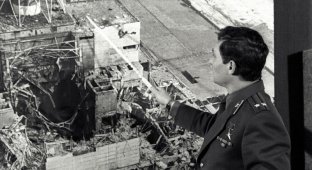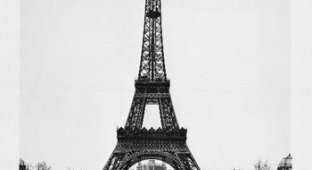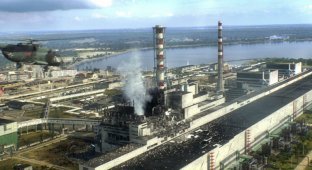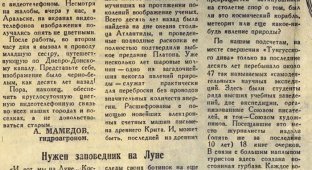In addition to people, equipment also took part in eliminating the consequences of the Chernobyl accident. This post is dedicated to technology, or more precisely to cranes, including unique ones.

These are port cranes. There were several of them, one of them was floating. With their help, crushed stone and sand, cement and other materials were unloaded onto the shore for the construction of the future sarcophagus over the fourth power unit. The port was relatively young and was never able to operate at full capacity.

Floating crane.

Portal cranes.


Gearbox valve 10/12.5.

And here are the cranes that were directly involved in the construction. These are Demag brand cranes.
In the photo: raising one and parts of the wall of the future Sarcophagus. Number 16 or 21

There were three cranes in total, serial numbers: 41016, 41020, 41021, then the cranes are distinguished by “combat numbers” and the last digits of the serial numbers (16,20,21)
- the first one (number 16) did not have a superlift; it can be distinguished by the absence of a lattice strut behind the tower (see photo). it had a lifting capacity of 500 tons
also on it the cabin is located not on the side but in the center of the tower, in addition, at the bottom of the tower there is something like a balcony.
- the second and third (numbers 20 and 21) had a superlift (an additional counterweight on pneumatic tires suspended from the spacer) i.e. they had a lattice strut to which counterweight trolleys with a total weight of 480 tons were suspended; these cranes had a lifting capacity of 650 tons.
— regarding the location, 16 and 21 worked next to the power unit side (where the main structure of the Sarcophagus is mounted) and crane number 20 worked from the turbine room side.

The first one was sent to Leningrad NPP in 1987.
The 2nd (after the fall) was decontaminated and buried... directly at the industrial site itself. Partially, because during the construction of the new Sarcophagus, part of the caterpillar was dug up.
The 3rd one was dismantled in 1997 and sold by a construction company from Chernobyl (to one of the Baltic countries).
Number 21 presumably, because the cabin is lined and there is no superlift.


Chernobyl Nuclear Power Plant

Those cranes that worked near the walls of the sarcophagus had video cameras, which were used to guide them when installing structural parts. The viewing angle and working conditions were extremely difficult; it was necessary to be able to hit the target accurately in order to install the multi-ton structure in its place.
“In mid-June, platforms with the designs of three Demag cranes began to arrive at Teterev station. They began to be distinguished by the last digits of the serial number. Thus, cranes with serial numbers 41016, 41020, 41021 turned into short combat ones - 16th, 20th y, 21st. The installation work of these cranes was entrusted to MSU-116 of the Spetsmontazhmekhanizatsiya trust.
They were installed at a distance of about one kilometer from the fourth power unit. To imagine all the difficulties and dangers of this work, it is enough to say that the components and parts of each crane occupied 32 railway platforms during transportation, and the assembled crane weighed 1200 tons. At the installation site where the assembly was carried out, the background radiation was 200 mr/hour. But the installers of MSU-116, under the leadership of the head of the department, Vladimir Anatolyevich Kovalchuk, and the chief engineer of the department, Valery Davydovich Muchnik, at a site located a 15-minute walk from the destroyed unit, completed the task in the shortest possible time. By July 8, the designs of all three Demags were delivered to Chernobyl and already on July 21, ahead of schedule, the first Demag, No. 16, moved self-propelled to the emergency fourth block.

At the most crucial moments of assembly, adjustment, and then delivery of the cranes to the block, K. N. Kondyrev was next to his workers. Moreover, his optimism and confidence in success forced him to do the almost impossible.”
Demag crane assembly.

Demag crane tracks.

Any breakdown of the cranes, leading to their stop, paralyzed the construction of the Sarcophagus. There was an immediate reaction from the Government Commission, big and small bosses, whose work directly depended on the serviceability of the cranes. Phone calls and threats came from all sides, but, despite the extremely nervous situation and exhaustion of physical strength, our people sometimes did the impossible. The taps were working. The construction schedule was on track.
For three or four days, when the installation of cascade walls, turbine hall floors, main load-bearing beams and other large structures was underway, our people did not leave the station. In the “bunker” (6th mark of the KhZhTO) repair teams were formed, operational decisions were made, and food was eaten, brought in plastic bags from Chernobyl. If we succeeded, we grabbed an hour or two of sleep on the beds located right there, covered with foam rubber. Enormous assistance to our specialists was provided by military personnel called up for six-month training, whom, apparently, because of their paramilitary appearance, everyone called “partisans.” The fathers of families, wise with life experience, often highly qualified specialists, 40-45 year old men, did not refuse any work, just to quickly fulfill their duty and return home. Sometimes, not understanding the danger they faced during a long stay in the radiation zone, they performed the most difficult work. Voluntarily, under the guidance of our specialists, they repaired components and assemblies of cranes and replaced broken two-meter crawler tracks. They dismantled the huge pneumatic wheels of the superlift, punctured by the reinforcement, and manually unloaded and reloaded the containers of the self-propelled counterweight with 40-kilogram lead ingots. In cases where the brigade’s mission was taking a long time, a decision was made to remove people from the radioactive zone and a petition was signed to the unit commander for the early demobilization of the “partisans.” They were replaced by new volunteers and brought the job to completion.
To help these “mastodons” there were another telescopic cranes - Liebherr.

In total, 3 Liebherr brand cranes are mentioned in various sources. 1st crane – LT-1300, designed for 300 tons. 2 more cranes designed for 80 tons.
He, “LIEBHER” with a capacity of 250 tons (or even 350, I don’t remember), was supposed to come to the construction of the Ignalina Nuclear Power Plant (Lit. SSR), but that was not fate. Therefore, without unloading, it (5 cars) was sent to Sosnovy Bor, where both cabins and the computer were lined with lead. They hooked up another carriage, a passenger one, and sent it to Chernobyl in a lettered form (after leading, the dimensions exceeded the railway workers’ tolerances). The accompanying party drank a little on the way. At the terminus there was one carriage missing, with spare parts, we looked for it, but couldn’t find it. The crane never needed any spare parts.
When the crane was working on the site, the driver and crane operator were brought to it by bus and quickly swapped places with the previous crew. They worked no more than half an hour per call. The next one depended on the dose received.

Liebherr cranes were used in the assembly of Demag cranes, during the construction of the Shelter, as well as during the cleaning of the roof of the 3rd power unit from radioactive debris. The further fate of this equipment is not reliably known, but the Liebherr LT-1300 is definitely stored along with the remains of one of the Demags (where is unknown).

A Manitowoc crawler crane is currently taking part in the construction.

For radiation reconnaissance, they made a chamber that looked like a deep-sea bathyscaphe. Its body was made of steel and lead, and the porthole was made of special thick glass that does not transmit radiation. The specialists who boarded this “bathyscaphe” were lifted above the nuclear ruins on a crane. The liquidators made one such cabin on their own back in June in Chernobyl and used it initially for a short rest - a person monitored the installation work, then ran out, raised the rafters and returned to the protection of lead. The second Bathyscaphe was factory-built, weighing 25 tons. Internal dimensions - 1.5 by 2 meters. It was hooked on top by a crane hook and lifted to any height.
There was always a dosimetrist in the cabin and a walkie-talkie. The “bathyscaphe” could be mounted on a ceiling, on a wall, in a rubble and left for a short time; it could simply hover in the air to inspect and measure any place. Outside the cabin - 150 roentgens/hour, and inside - only 0.2 roentgens. Engineers, designers, designers, and installers “flyed” in the Bathyscaphe.




























